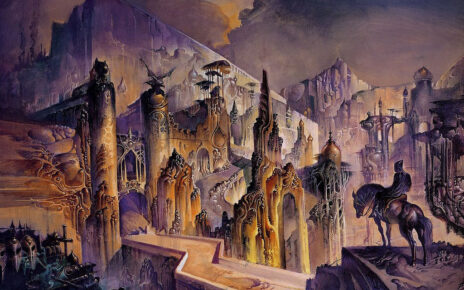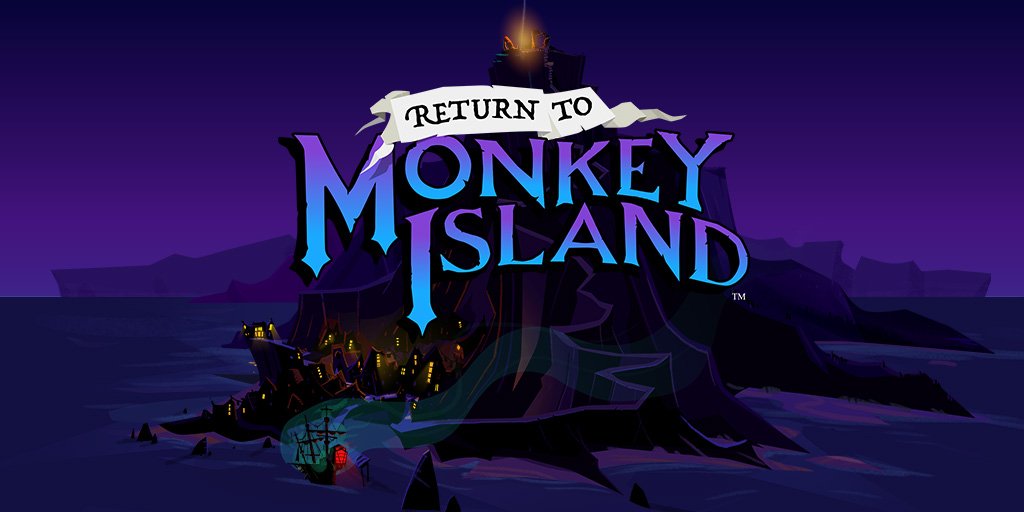
Return to Monkey Island is here and so I’ve decided to try my hand at giving it a review. But since I cannot do anything without bringing up nostalgia, first we have to talk a little about my introduction to the series.
I received Curse of Monkey Island (1997) as a kid for my birthday. I still remember seeing the box at my grandparent’s house. It was the first video game they had ever given me. No doubt, my father read a review for it in a PC gaming magazine and recommended they get it for me. When playing I was captivated by the gorgeous art pieces that this game was made of. It was just so unlike anything I’d ever seen in a video game at the time, much less a PC game.
Curse was my introduction to the Monkey Island series and the adventure game genre as a whole. I played a bit of it and received the two-pack Monkey Island Madness CD-ROM not long after that contained the first two games: The Secret of Monkey Island (1990) and Monkey Island 2: LeChuck’s Revenge (1991).
Now, two decades and two games later (there were only two games after Curse?? It feels like more!) I find myself playing Return to Monkey Island (2022). Ron Gilbert and Dave Grossman, creators of the original MI and MI2, have come back to this series to give us a new entry. Marketing and pre-release info indicated it would be set directly after the end of MI2 but would retain consistency with the entirety of the Monkey Island series (something that Escape from Monkey Island (2000), MI4, makes difficult). With this mantra and these developers behind the game, surely we have a winner on our hands, right? I mean, we know that Ron Gilbert still has the magic. Thimbleweed Park (2017) was an excellent throwback to adventure games of old yet it still works in a modern era. So there should be little cause for concern with RtMI, right? Well let’s break it down.
SURFACE ELEMENTS (Art, Music, Acting)
The art for RtMI immediately triggered the internet when it was revealed. It seemed that a lot of fans expected another pixel art game, like Thimbleweed. However, MI as a series has never been beholden to pixel art. Only two games in the series feature that style and that was simply due to technical limitations of the era. Every game since MI2 has featured a different artistic style.
I personally didn’t care for the art style of RtMI when I first saw it in pre release material, but seeing it in-game is a different experience. It works quite well, especially in close-up scenes. And when playing through the game I can’t say that the unique approach to characterization ever took me out of the experience.
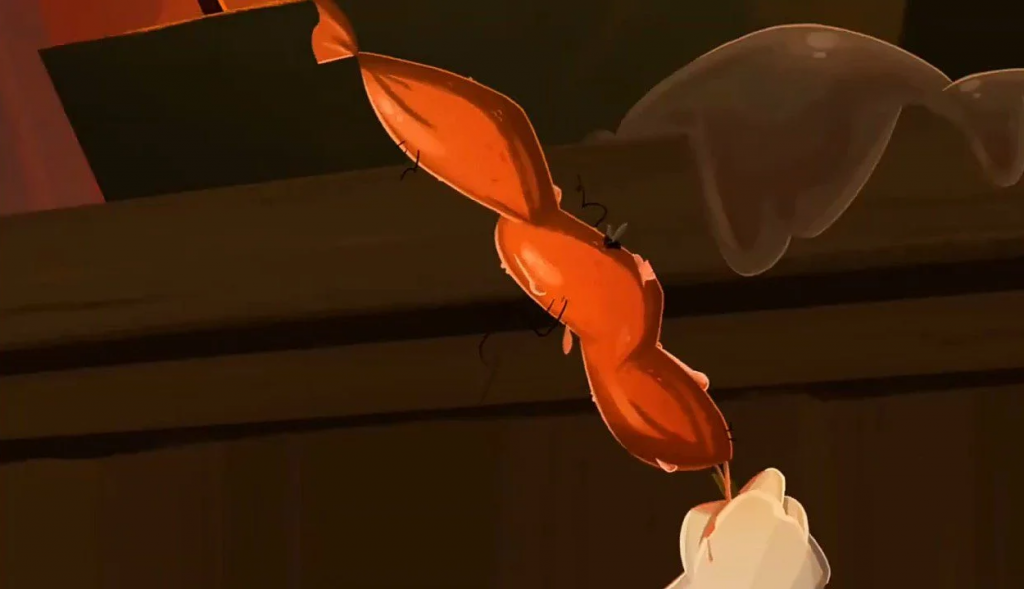
The music is satisfying. There weren’t many (any?) new pieces here, but it definitely captured the Monkey Island spirit of old. I find myself with very little else to say about it, honestly. I don’t know if that’s a good or a bad thing. I enjoyed the music as I always do with Monkey Island. I don’t think I’ve ever found myself wishing they would innovate in that department. Changing things up too much might disrupt the tone of this franchise.
The voice acting is mostly on point. Dominic Armato returns to voice Guybrush as does Donny Delk for the voice of Murray, the sardonic disembodied skull. Both of these actors are fantastic and I could never picture anyone else voicing their respective characters. Their deliveries are as consistently funny as ever.
A new throat amongst the cast, Jess Harnell, is here providing the voice for LeChuck. There’s certainly nothing bad I can say about the actor. He delivers his lines as he should and he does as good an impersonation of the previous LeChuck actors as one could expect. Perhaps I am hearing this game through nostalgia earbuds (I tried the goggles, but I couldn’t hear a thing through them), but Harnell’s voice feels like it’s missing something…extra. His delivery isn’t quite as exaggerated as the OG LeChuck, Earl Boen. It feels slightly less authentic. It’s not even quite as close to the original as Kevin Blackton’s attempt in Tales of Monkey Island (2009).
Ultimately this isn’t that much of an issue, though. I honestly think MI’s humor lands better when you…turn off the voices. There I said it. I actually rarely do this myself as I do enjoy the acting in these games. But Monkey 1 and Monkey 2 were written to be read. It’s much the same problem I have with watching the live action adaptations of Terry Pratchett’s work. No actor can match the comedic delivery that your own brain conjures. A line delivery is something that an actor has learned will appeal to the masses. The latter is something that your mind has attuned to your specific tastes.
GAMEPLAY (Exploration, puzzles)
It must have been several years after first getting into the series before I completed any of the first three games on my own and I’m sure that I didn’t do so without a guide. As a kid I was more interested in experiencing the story and mechanics, even if I didn’t figure things out on my own. I never felt like that sense of accomplishment was robbed if I looked up a hint.
Those days are long gone, however, and now it bugs me if I need to resort to looking up hints to get around a puzzle. The primary gameplay loop of these games ARE the puzzles; getting help to circumvent one of the puzzles would be like handing the controller off to somone else to finish a level of Halo or battle a boss in Dragon Quest for me. So for my playthrough of Return to Monkey Island I was determined to not look up a single hint, even though the game was gracious enough to provide it’s own in-game hintbook, a hearkening back the Universal Hint System, a website that was the perfect solution for when you got stuck in an adventure game but didn’t want to have the answer explicitly given to you.
As stated, I decided not to use the hintbook no matter how tempting it was and…I forgot it was even there. This game is the easiest adventure game I’ve played since the Humongous Entertainment point n’ click games I played as a kid. Many of the puzzles lack any depth and have obvious solutions. There were a few times when I encountered the solution before I happened upon the puzzle. This has to be Return to Monkey Island’s weakest point. You can say what you will about the art or the writing, but a point n’ click adventure game with weak puzzles is a weak game. Perhaps there is some value here for a parent wanting an easy game to expose their child to the franchisee (or the genre with), but for returning veterans of adventure games, you will find little challenge here. And it’s the latter audience that Return to Monkey Island is probably targeting (it’s in the name).
As for the exploration, this is yet another miss. There are scant new areas, with the majority of the game taking place on Melee Island and a short diversion to Monkey Island itself, both being areas that we’ve already been to in two games in the series already.
Monkey Island proper feels…out of place in this game. That might sound silly to the initiated, but there’s no rule that says we need to feature Monkey Island in a Monkey Island game. It appeared in the first and fourth games only. The rest of the series had very little to do with Monkey Island at all. As much as Escape (MI4) missed the mark on a lot of things, it was kind of nice getting to revisit old areas from the first game to see how they’ve changed. Did we really need to go back a second time in Return? The time spent on Monkey Island in Return was rather short and, again, didn’t do very much to serve the overall plot. It was primarily a macguffin for what was the most engaging segment in the game, something I will address later.
There are a few new islands to visit, but most of them only have three or four “rooms” within. The exception to this is Terror Island, which has about six or seven different “rooms” but only two of them have anything to actually interact with. The rest can trigger some dialogue from Guybrush, but that is all. Most of Terror Island suspiciously smells of cut content. In fact, a lot of this game smells like cut content.
There is no minigame akin to insult swordfighting, Monkey Kombat or the like. I must have replayed the middle portion of Curse ten or fifteen times a kid, going through the insult swordfighting progression mechanic and upgrading my ship for sea battles. It wasn’t a significant part of the game, but it was fleshed out enough to be engaging and fun yet short enough to not slow the game down.
Nothing like that exists in Return to Monkey Island. There was a brief moment where I thought storytelling would be the minigame gimmick, but it served its use in only one scenario to move the plot along and had no further purpose. It’s only speculation, but it feels as though this might have been a planned mechanic with more depth but was abbreviated due to time constraints. Regardless if that’s true or not, it seems that pressure to release this game resulted in a notable lack of depth.
AHOY! THERE BE SPOILERS AHEAD! YE’VE BEEN WARNED.
So, first of all, the classic Monkey island comedy is present in this game, though to get its full effect you need to enable the “Writer’s Cut” in the options. Why they disabled this by default, one can only speculate. But it was really refreshing to get to experience classic MI storytelling in 2022.
The writing for Murray and Guybrush is spot on and feels like it could come from any one of the past MI games. There’s no shortage of charm here as far as the dialogue is concerned.
There’s a significant portion of the game that has you joining LeChuck’s crew incognito to follow them to Monkey Island. There you have to interact with his crew in various different puzzles and the characterization of them all outshines nearly every other bit of writing in the game. This entire act stands out the most in memory and was undoubtedly my favorite part of the game. I don’t know these characters are so much more fleshed out than Elaine or LeChuck, himself. Perhaps the writers felt that they didn’t need to do much with the existing characters but did feel inspired with the new ones?
Unfortunately, that is where my praise has to end for the writing. RtMI tricks you by making you think they’re doing some character development with Elaine and Guybrush, but in the end it goes nowhere, leaving loose threads untied and the player scratching their head.
There’s this running plot thread that both Guybrush and LeChuck are destructive to the environments around them and consistently abuse and exploit everyone and everything around them to reach their goal. It’s a fun meta-commentary on the nature of adventure games. Who cares if we abandon our crew on Monkey Island in the first game? We have to follow LeChuck back to Melee and stop him? What does it matter if I destroy a natural habitat in RtMI? I need to cut down that mop tree so I can sneak onto LeChuck’s ship!
There are multiple cutscenes of Elaine following in Guybrush’s footsteps in this game, learning about the harm he’s caused while searching for the Secret of Monkey Island. There are many parallels drawn between Guybrush and LeChuck showing that, to those around them, they are not much different from one another. There’s even a CHECKLIST provided when you join LeChuck’s crew that ticks off each of Guybrush’s sins as he commits them, showing that he truly does have what it takes to be as evil as LeChuck himself.
But as I said, this goes unresolved. The Elaine plot thread builds to a confrontation just before the end, where you think she’s going to call him out on his bad behavior. And she does. And then she drops it and engages in a swordfight to hold off one of the villains while Guybrush forges on ahead to catch up to LeChuck. That’s all there is to it. It left me wondering what all the Elaine cutscenes were even for. Was it really just trick me into thinking there would be a resolution? Was this a storyline that got cut during development? Who knows?
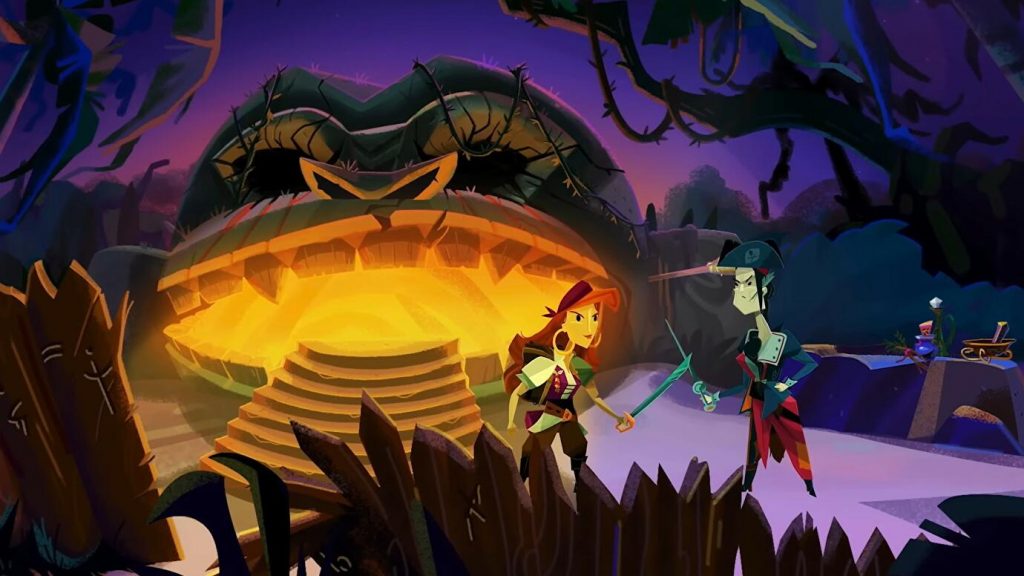
This might be more easily dismissed if Guybrush actually did catch up to LeChuck in some sort of grand showdown, but he doesn’t. The last we see of LeChuck, (REAL LeChuck) is him disappearing into a portal leaving Guybrush to solve the final puzzle to follow in after him.
And once Guybrush does follow him into the portal, Ron Gilbert falls back into full meta-mode. Guybrush exits the door in the alley behind the church on Melee Island and it’s revealed that it was all a theme park.
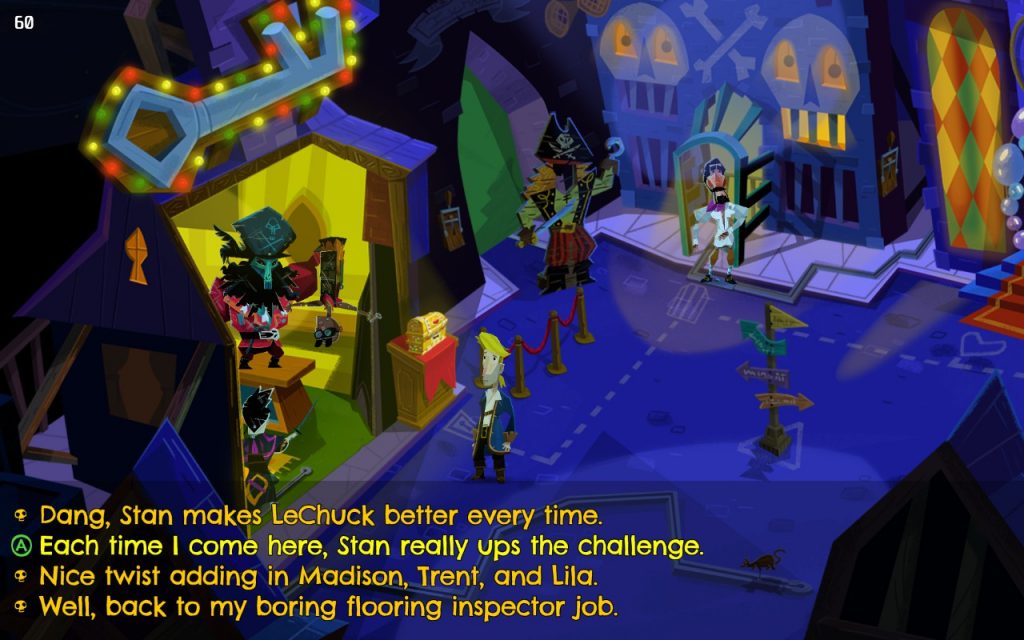
I shouldn’t have expected anything different. This is the third time Gilbert has written this ending and it’s the second time he’s put it in an MI game. Although, I’ll admit that this time he has left it more up in the air as to whether or not the events of the game actually happened.
In MI2, the ending reveals that Guybrush and LeChuck were just children pretending to be pirates in an amusement park. Curse of Monkey Island retconned this as a delusion Guybrush was given by LeChuck’s voodoo magic. RtMI then re-retcons that ending as being Guybrush’s kids playing out his former adventures.
And in the ending of RtMI, Guybrush finds the chest that contains the Secret of Monkey Island. He opens it and inside is a t-shirt. Stan then approaches Guybrush and tells him to turn the lights off before he leaves. Elaine shows up and, sounding much like the mother of a ten year old, tells Guybrush they need to leave. The Secret of Monkey Island wasn’t the shirt. The secret was that the game was actually a theme park attraction based on a previous event. The entirety of the game of RtMI was Guybrush reliving a past adventure. It happened, but we never got to see the actual events, only a recreation.
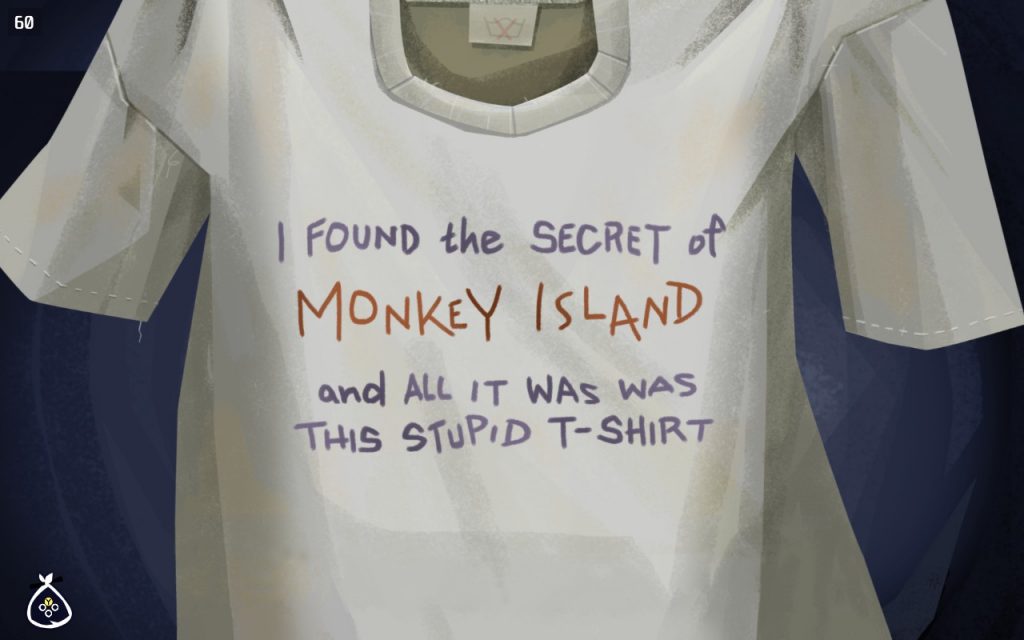
I don’t hate meta endings. When done right, they can be a lot of fun. In a vacuum, the kind of ending that Ron attempts with MI can be quirky and unique. I personally feel that it worked in Thimbleweed Park. But for a multi-game franchise it strains the continuity.
The reason behind the meta ending is to preach the moral that the journey is more important than the destination. Okay, I get that. I actually completely agree. We play adventure games primarily for the unfolding of the story and the challenge of the puzzles.
But this moral falls hard on its face when you consider that the journey in RtMI was comparatively lackluster. The story was building to something that never materialized in terms of character development. The puzzles were incredibly simple and easy. I can’t say that there was much on the journey to enjoy other than the thematic atmosphere of a new Monkey Island game.
I refrain from using this word as much as possible, but I find the ending to be pretentious, by definition. It is preaching a sermon to us, but the words have no value. It’s hard not to feel insulted by that. Ron thinks we’re focusing on the wrong part of the game. But we’re not. Had the gameplay been better then perhaps fans wouldn’t have reacted to the ending with as much anger as they did. There’s a reason why Monkey 2 is my favorite game in the series even though it basically has the same ending. The environments are engaging. There are many areas to explore. The puzzles are mostly great. We get to face off against LeChuck in a tense puzzle in the tunnels below Dinky Island. And we get to see the progression of relationships set up in the previous game. It didn’t matter that the ending cutscene took the air out of the story we’d just played (okay, it did matter…people have complained about this for decades…but I posit that the game was not ruined by that ending) because the journey to the destination was still fun and rewarding.
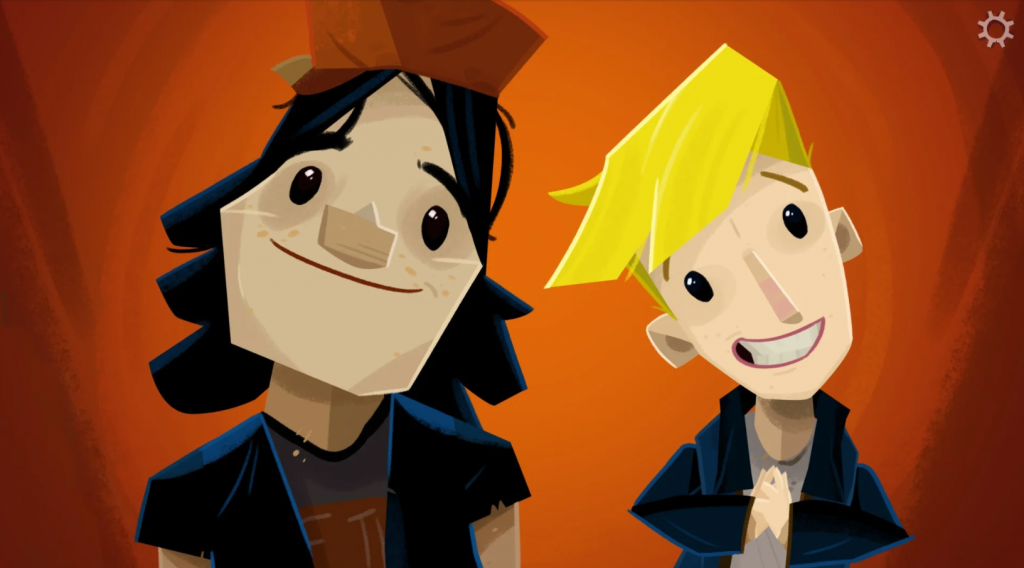
Conclusion
All in all, Return to Monkey Island was a mediocre game with shallow content, non-challenging puzzles, and a bad ending whose message is in conflict with the experience the game offers. And saying all of that makes me rather sad.
I did enjoy my time with the game. Revisiting the MI atmosphere was like visiting an old friend. And the easy puzzles did in fact make it a simple thing to breeze through. I would have enjoyed it more had I been challenged, though I suppose I should be thankful that they didn’t throw in moon logic as a substitute for a challenge.
Have a young child that you want to introduce to Point n Click adventure games? Then I recommend…well, then I recommend Putt-Putt Saves the Zoo or one of the other Humongous Entertainment games. But putting those aside, I would recommend Return to someone looking for a game to fit that role. The easy puzzles will allow them to progress the story without as much frustration and will serve as an introduction to classic adventure game comedy and tropes of our childhoods.
But if you’re looking for a Curse of Monkey Island killer, this isn’t it.

